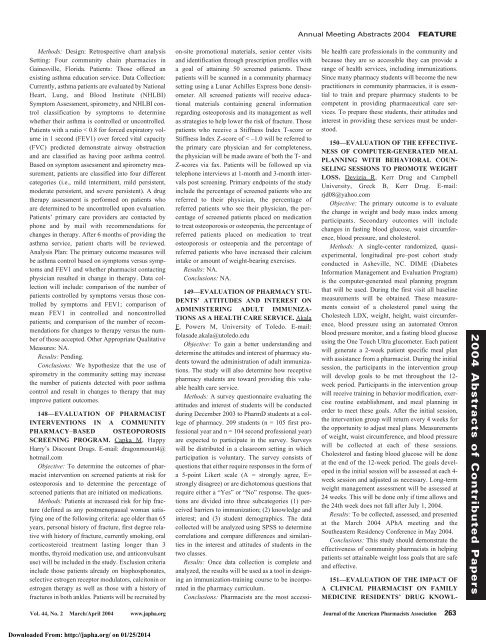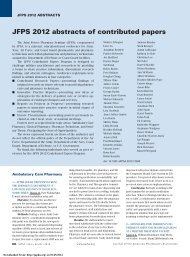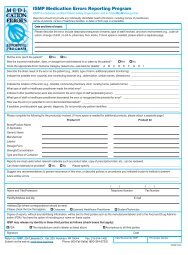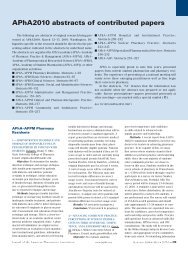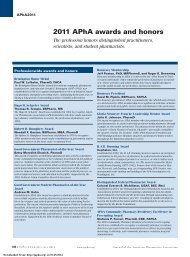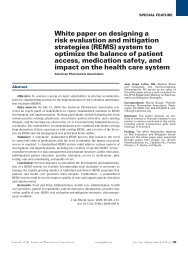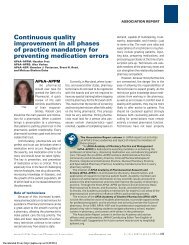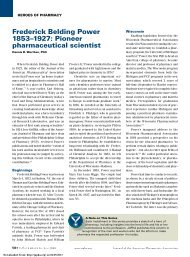Downloaded - Journal of American Pharmacists Association
Downloaded - Journal of American Pharmacists Association
Downloaded - Journal of American Pharmacists Association
Create successful ePaper yourself
Turn your PDF publications into a flip-book with our unique Google optimized e-Paper software.
Annual Meeting Abstracts 2004<br />
FEATURE<br />
Methods: Design: Retrospective chart analysis<br />
Setting: Four community chain pharmacies in<br />
Gainesville, Florida. Patients: Those <strong>of</strong>fered an<br />
existing asthma education service. Data Collection:<br />
Currently, asthma patients are evaluated by National<br />
Heart, Lung, and Blood Institute (NHLBI)<br />
Symptom Assessment, spirometry, and NHLBI control<br />
classification by symptoms to determine<br />
whether their asthma is controlled or uncontrolled.<br />
Patients with a ratio < 0.8 for forced expiratory volume<br />
in 1 second (FEV1) over forced vital capacity<br />
(FVC) predicted demonstrate airway obstruction<br />
and are classified as having poor asthma control.<br />
Based on symptom assessment and spirometry measurement,<br />
patients are classified into four different<br />
categories (i.e., mild intermittent, mild persistent,<br />
moderate persistent, and severe persistent). A drug<br />
therapy assessment is performed on patients who<br />
are determined to be uncontrolled upon evaluation.<br />
Patients’ primary care providers are contacted by<br />
phone and by mail with recommendations for<br />
changes in therapy. After 6 months <strong>of</strong> providing the<br />
asthma service, patient charts will be reviewed.<br />
Analysis Plan: The primary outcome measures will<br />
be asthma control based on symptoms versus symptoms<br />
and FEV1 and whether pharmacist contacting<br />
physician resulted in change in therapy. Data collection<br />
will include: comparison <strong>of</strong> the number <strong>of</strong><br />
patients controlled by symptoms versus those controlled<br />
by symptoms and FEV1; comparison <strong>of</strong><br />
mean FEV1 in controlled and noncontrolled<br />
patients; and comparison <strong>of</strong> the number <strong>of</strong> recommendations<br />
for changes to therapy versus the number<br />
<strong>of</strong> those accepted. Other Appropriate Qualitative<br />
Measures: NA.<br />
Results: Pending.<br />
Conclusions: We hypothesize that the use <strong>of</strong><br />
spirometry in the community setting may increase<br />
the number <strong>of</strong> patients detected with poor asthma<br />
control and result in changes to therapy that may<br />
improve patient outcomes.<br />
148—EVALUATION OF PHARMACIST<br />
INTERVENTIONS IN A COMMUNITY<br />
PHARMACY–BASED OSTEOPOROSIS<br />
SCREENING PROGRAM. Capka M, Happy<br />
Harry’s Discount Drugs. E-mail: dragonmount4@<br />
hotmail.com<br />
Objective: To determine the outcomes <strong>of</strong> pharmacist<br />
intervention on screened patients at risk for<br />
osteoporosis and to determine the percentage <strong>of</strong><br />
screened patients that are initiated on medications.<br />
Methods: Patients at increased risk for hip fracture<br />
(defined as any postmenopausal woman satisfying<br />
one <strong>of</strong> the following criteria: age older than 65<br />
years, personal history <strong>of</strong> fracture, first degree relative<br />
with history <strong>of</strong> fracture, currently smoking, oral<br />
corticosteroid treatment lasting longer than 3<br />
months, thyroid medication use, and anticonvulsant<br />
use) will be included in the study. Exclusion criteria<br />
include those patients already on bisphosphonates,<br />
selective estrogen receptor modulators, calcitonin or<br />
estrogen therapy as well as those with a history <strong>of</strong><br />
fractures in both ankles. Patients will be recruited by<br />
on-site promotional materials, senior center visits<br />
and identification through prescription pr<strong>of</strong>iles with<br />
a goal <strong>of</strong> attaining 50 screened patients. These<br />
patients will be scanned in a community pharmacy<br />
setting using a Lunar Achilles Express bone densitometer.<br />
All screened patients will receive educational<br />
materials containing general information<br />
regarding osteoporosis and its management as well<br />
as strategies to help lower the risk <strong>of</strong> fracture. Those<br />
patients who receive a Stiffness Index T-score or<br />
Stiffness Index Z-score <strong>of</strong> < –1.0 will be referred to<br />
the primary care physician and for completeness,<br />
the physician will be made aware <strong>of</strong> both the T- and<br />
Z-scores via fax. Patients will be followed up via<br />
telephone interviews at 1-month and 3-month intervals<br />
post screening. Primary endpoints <strong>of</strong> the study<br />
include the percentage <strong>of</strong> screened patients who are<br />
referred to their physician, the percentage <strong>of</strong><br />
referred patients who see their physician, the percentage<br />
<strong>of</strong> screened patients placed on medication<br />
to treat osteoporosis or osteopenia, the percentage <strong>of</strong><br />
referred patients placed on medication to treat<br />
osteoporosis or osteopenia and the percentage <strong>of</strong><br />
referred patients who have increased their calcium<br />
intake or amount <strong>of</strong> weight-bearing exercises.<br />
Results: NA.<br />
Conclusions: NA.<br />
149—EVALUATION OF PHARMACY STU-<br />
DENTS’ ATTITUDES AND INTEREST ON<br />
ADMINISTERING ADULT IMMUNIZA-<br />
TIONS AS A HEALTH CARE SERVICE. Akala<br />
F, Powers M, University <strong>of</strong> Toledo. E-mail:<br />
folasade.akala@utoledo.edu<br />
Objective: To gain a better understanding and<br />
determine the attitudes and interest <strong>of</strong> pharmacy students<br />
toward the administration <strong>of</strong> adult immunizations.<br />
The study will also determine how receptive<br />
pharmacy students are toward providing this valuable<br />
health care service.<br />
Methods: A survey questionnaire evaluating the<br />
attitudes and interest <strong>of</strong> students will be conducted<br />
during December 2003 to PharmD students at a college<br />
<strong>of</strong> pharmacy. 209 students (n = 105 first pr<strong>of</strong>essional<br />
year and n = 104 second pr<strong>of</strong>essional year)<br />
are expected to participate in the survey. Surveys<br />
will be distributed in a classroom setting in which<br />
participation is voluntary. The survey consists <strong>of</strong><br />
questions that either require responses in the form <strong>of</strong><br />
a 5-point Likert scale (A = strongly agree, E=<br />
strongly disagree) or are dichotomous questions that<br />
require either a “Yes” or “No” response. The questions<br />
are divided into three subcategories (1) perceived<br />
barriers to immunization; (2) knowledge and<br />
interest; and (3) student demographics. The data<br />
collected will be analyzed using SPSS to determine<br />
correlations and compare differences and similarities<br />
in the interest and attitudes <strong>of</strong> students in the<br />
two classes.<br />
Results: Once data collection is complete and<br />
analyzed, the results will be used as a tool in designing<br />
an immunization-training course to be incorporated<br />
in the pharmacy curriculum.<br />
Conclusions: <strong>Pharmacists</strong> are the most accessible<br />
health care pr<strong>of</strong>essionals in the community and<br />
because they are so accessible they can provide a<br />
range <strong>of</strong> health services, including immunizations.<br />
Since many pharmacy students will become the new<br />
practitioners in community pharmacies, it is essential<br />
to train and prepare pharmacy students to be<br />
competent in providing pharmaceutical care services.<br />
To prepare these students, their attitudes and<br />
interest in providing these services must be understood.<br />
150—EVALUATION OF THE EFFECTIVE-<br />
NESS OF COMPUTER-GENERATED MEAL<br />
PLANNING WITH BEHAVIORAL COUN-<br />
SELING SESSIONS TO PROMOTE WEIGHT<br />
LOSS. Devizia R, Kerr Drug and Campbell<br />
University, Greck B, Kerr Drug. E-mail:<br />
rjd08@yahoo.com<br />
Objective: The primary outcome is to evaluate<br />
the change in weight and body mass index among<br />
participants. Secondary outcomes will include<br />
changes in fasting blood glucose, waist circumference,<br />
blood pressure, and cholesterol.<br />
Methods: A single-center randomized, quasiexperimental,<br />
longitudinal pre–post cohort study<br />
conducted in Asheville, NC. DIME (Diabetes<br />
Information Management and Evaluation Program)<br />
is the computer-generated meal planning program<br />
that will be used. During the first visit all baseline<br />
measurements will be obtained. These measurements<br />
consist <strong>of</strong> a cholesterol panel using the<br />
Cholestech LDX, weight, height, waist circumference,<br />
blood pressure using an automated Omron<br />
blood pressure monitor, and a fasting blood glucose<br />
using the One Touch Ultra glucometer. Each patient<br />
will generate a 2-week patient specific meal plan<br />
with assistance from a pharmacist. During the initial<br />
session, the participants in the intervention group<br />
will develop goals to be met throughout the 12-<br />
week period. Participants in the intervention group<br />
will receive training in behavior modification, exercise<br />
routine establishment, and meal planning in<br />
order to meet these goals. After the initial session,<br />
the intervention group will return every 4 weeks for<br />
the opportunity to adjust meal plans. Measurements<br />
<strong>of</strong> weight, waist circumference, and blood pressure<br />
will be collected at each <strong>of</strong> these sessions.<br />
Cholesterol and fasting blood glucose will be done<br />
at the end <strong>of</strong> the 12-week period. The goals developed<br />
in the initial session will be assessed at each 4-<br />
week session and adjusted as necessary. Long-term<br />
weight management assessment will be assessed at<br />
24 weeks. This will be done only if time allows and<br />
the 24th week does not fall after July 1, 2004.<br />
Results: To be collected, assessed, and presented<br />
at the March 2004 APhA meeting and the<br />
Southeastern Residency Conference in May 2004.<br />
Conclusions: This study should demonstrate the<br />
effectiveness <strong>of</strong> community pharmacists in helping<br />
patients set attainable weight loss goals that are safe<br />
and effective.<br />
151—EVALUATION OF THE IMPACT OF<br />
A CLINICAL PHARMACIST ON FAMILY<br />
MEDICINE RESIDENTS’ DRUG KNOWL-<br />
2004 Abstracts <strong>of</strong> Contributed Papers<br />
Vol. 44, No. 2 March/April 2004 www.japha.org <strong>Journal</strong> <strong>of</strong> the <strong>American</strong> <strong>Pharmacists</strong> <strong>Association</strong> 263<br />
<strong>Downloaded</strong> From: http://japha.org/ on 01/25/2014


